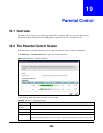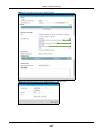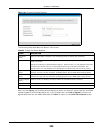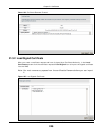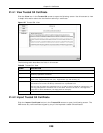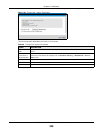
VMG5313-B10A/-B30A Series User’s Guide
243
CHAPTER 21
Certificates
21.1 Overview
The VMG can use certificates (also called digital IDs) to authenticate users. Certificates are based
on public-private key pairs. A certificate contains the certificate owner’s identity and public key.
Certificates provide a way to exchange public keys for use in authentication.
21.1.1 What You Can Do in this Chapter
•The Local Certificates screen lets you generate certification requests and import the VMG's CA-
signed certificates (Section 21.4 on page 247).
•The Trusted CA screen lets you save the certificates of trusted CAs to the VMG (Section 21.4 on
page 247).
21.2 What You Need to Know
The following terms and concepts may help as you read through this chapter.
Certification Authority
A Certification Authority (CA) issues certificates and guarantees the identity of each certificate
owner. There are commercial certification authorities like CyberTrust or VeriSign and government
certification authorities. The certification authority uses its private key to sign certificates. Anyone
can then use the certification authority's public key to verify the certificates. You can use the VMG
to generate certification requests that contain identifying information and public keys and then send
the certification requests to a certification authority.
21.3 The Local Certificates Screen
Click Security > Certificates to open the Local Certificates screen. This is the VMG’s summary
list of certificates and certification requests.



